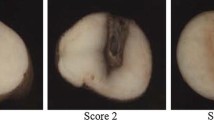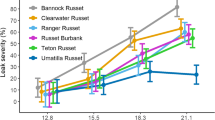Abstract
Bacterial soft rot is a serious disease in potato (Solanum tuberosum L.), causing rapid tuber tissue maceration and, consequently, marketable yield loss. Soft rot bacteria, including Pectobacterium carotovorum subsp. carotovorum (Pbc), are favored by moist conditions, which are prevalent in large potato storage facilities. However, although most potatoes in North America are stored before use, there are no published surveys of soft rot resistance in cultivars exposed to long-term storage conditions. Thus, we tested 65 cultivars and 13 breeding lines for soft rot resistance after 6 months of storage. There was a significant effect of cultivar and production environment on soft rot resistance score. During 6 months of storage, tuber soft rot resistance in resistant clones did not change, while it changed in susceptible clones. The three most resistant cultivars to soft rot were Freedom Russet, Anett, and Alaska Red Eye.
Resumen
La pudrición blanda bacteriana es una enfermedad seria en papa (Solanum tuberosum L.), causando una maceración rápida del tejido del tubérculo, y consecuentemente, pérdida en rendimiento comercial. Las bacterias de la pudrición blanda, incluyendo Pectobacterium carotovorum subsp. Carotovorum (Pbc), son favorecidas por condiciones húmedas, que son prevalecientes en grandes instalaciones de almacenamiento de papa. No obstante, aun cuando la mayor parte de las papas en Norteamérica se almacenan antes de su uso, no hay estudios publicados de resistencia a la pudrición blanda en variedades expuestas a condiciones de almacenamiento por largo tiempo. De aquí que probamos 65 variedades y 13 líneas de mejoramiento para resistencia a la pudrición blanda después de seis meses de almacenamiento. Hubo un efecto significativo de variedad y de ambiente de producción en la calificación de resistencia a la pudrición blanda. Durante seis meses de almacenamiento, la resistencia del tubérculo a la pudrición blanda en clones resistentes no cambió, mientras que sí cambió en clones susceptibles. Las tres variedades más resistentes a la pudrición blanda fueron Freedom Russet, Anett, y Alaska Red Eye.
Similar content being viewed by others
References
Bain, R.A., and M.C.M. Pérombelon. 1988. Methods of testing potato cultivars for resistance to soft rot of tubers caused by Erwinia carotovora subsp. atroseptica. Plant Pathology 37: 431–437.
Bartz, J.A., S.J. Locascio, and D.P. Weingartner. 1992. Calcium and potassium fertilization of potatoes grown in north Florida. II. Effects on the bacterial soft rot potential in the tubers. American Potato Journal 69: 39–50.
Coleman, W.K. 2000. Physiological ageing of potato tubers: A review. Annals of Applied Biology 137: 189–199.
Cother, E.J., and B.R. Cullis. 1987. Seed tuber susceptibility to Erwinia chrysanthemi: Evaluation of altered tuber physiology as a means of reducing incidence and severity of soft rot. Potato Research 30: 229–240.
Demarty, M., C. Morvan, and M. Thellier. 1984. Calcium and the cell wall. Plant Cell and Environment 7: 441–448.
Haynes, K.G., W.J.E. Potts, and R.W. Goth. 1997. Evaluation of the reliability of determining soft rot resistance in potatoes by the tuber slice method. American Potato Journal 74: 265–275.
Hirschi, K.D. 2004. The calcium conundrum. Both versatile nutrient and specific signal. Plant Physiology 136: 2438–2442.
Koppel, M. 1993. Methods of assessing potato tubers for resistance to bacterial soft rot. Potato Research 36: 183–188.
Kushalappa, A.C., and M. Zulfiqar. 2001. Effect of wet incubation time and temperature on infection, and of storage time and temperature on soft rot lesion expansion in potatoes inoculated with Erwinia carotovora ssp. carotovora. Potato Research 44: 233–242.
Lapwood, D.H., and P.J. Read. 1985. A simplified slice method for assessing tuber susceptibility of potato cultivars to Erwinia carotovora subsp. atroseptica. Plant Pathology 34: 284–286.
Lapwood, D.H., and P.J. Read. 1986. A comparison of methods of seed tuber inoculation for assessing the susceptibility of potato cultivars to blackleg (Erwinia carotovora subsp. atroseptica) in the field. Annals of Applied Biology 109: 287–297.
Lapwood, D.H., P.J. Read, and J. Spokes. 1984. Methods for assessing the susceptibility of potato tubers of different cultivars to rotting by Erwinia carotovora subspecies atroseptica and carotovora. Plant Pathology 33: 13–20.
Lojkowska, E., and A. Kelman. 1994. Comparison of the effectiveness of different methods of screening for bacterial soft rot resistance of potato tubers. American Potato Journal 71: 99–113.
Lyon, G.D. 1989. The biochemical basis of resistance of potatoes to soft rot Erwinia spp.—a review. Plant Pathology 38: 313–339.
McGuire, R.G., and A. Kelman. 1984. Reduced severity of Erwinia soft rot in potato tubers with increased calcium content. Phytopathology 74: 1250–1256.
McGuire, R.G., and A. Kelman. 1986. Calcium in potato tuber cell walls in relation to tissue maceration by Erwinia carotovora pv. atroseptica. Phytopathology 76: 401–406.
Otazu, V., and G.A. Secor. 1981. Soft rot susceptibility of potatoes with high reducing sugar content. Phytopathology 71: 290–295.
Palta, J.P. 1996. Role of calcium in plant responses to stresses: Linking basic research to the solution of practical problems. HortScience 31: 51–57.
Pérombelon, M.C.M. 2002. Potato diseases caused by soft rot erwinias: An overview of pathogenesis. Plant Pathology 51: 1–12.
Pérombelon, M.C.M., and A. Kelman. 1980. Ecology of soft rot Erwinias. Annual Review of Phytopathology 18: 361–387.
Pérombelon, M.C.M., and R. Lowe. 1975. Studies on the infection of bacterial soft rot in potato tubers. Potato Research 18: 64–82.
Robert, W.B., J.C. Leslie, Y.Y. Rickey, and G.M. Alejandro. 2002. Changes in compositional parameters of tubers of potato (Solanum tuberosum) during low-temperature storage and their relationship to chip processing quality. Journal of Agricultural Food Chemestry 50: 4545–4553.
Seling, S., A.H. Wissemeier, P. Cambier, and P.P. Van Cutsem. 2000. Calcium deficiency in potato (Solanum tuberosum ssp. tuberosum) leaves and its effect on the pectic composition of the apoplastic fluid. Physiologia Plantarum 109: 44–50.
Stewart, H.E., J.E. Bradshaw, and R.L. Wastie. 1994. Correlation between resistance to late blight in foliage and tubers in potato clones from parents of contrasting resistance. Potato Research 37: 429–434.
Tzeng, K.-C., R.G. McGuire, and A. Kelman. 1990. Resistance of tubers from different potato cultivars to soft rot caused by Erwinia carotovora subsp. atroseptica. American Potato Journal 67: 287–305.
Van Ittersum, M.K., K. Scholte, and L.J.P. Kupers. 1990. A method to assess cultivar differences in rate of physiological ageing of seed tubers. American Potato Journal 67: 603–613.
Wolters, P.J.C.C., and W.W. Collins. 1995. Estimation of genetic parameters for resistance to Erwinia soft rot, specific gravity, and calcium concentration in diploid potatoes. Crop Science 35: 1346–1352.
Workman, M., and D.G. Holm. 1984. Potato clone variation in blackspot and soft rot susceptibility, redox potential, ascorbic acid, dry matter, and potassium. American Journal of Potato Research 61: 723–733.
Workman, M., E. Kerschner, and M. Harrison. 1976. The effect of storage factors on decay by Erwinia carotovora var. atroseptica and Fusarium roseum var. sambucicum. American Journal of Potato Research 53: 191–204.
Yap, M.-N., J.D. Barak, and A.O. Charkowski. 2004. Genomic diversity of Erwinia carotovora subsp. carotovora and its correlation with virulence. Applied and Environmental Microbiology 70: 3013–3023.
Zimnoch-Guzowska, E., and E. Lojkowska. 1993. Resistance to Erwinia spp. in diploid potato with a high starch content. Potato Research 36: 177–182.
Acknowledgements
We thank Emily Heenan for assisting with disease screening and Andy Hamernik for providing the tubers for this study. Partial funding was provided by USDA-NRI Grant 2009-55605-05219.
Author information
Authors and Affiliations
Corresponding author
Rights and permissions
About this article
Cite this article
Chung, Y.S., Goeser, N.J., Cai, X. et al. The Effect of Long Term Storage on Bacterial Soft Rot Resistance in Potato. Am. J. Potato Res. 90, 351–356 (2013). https://doi.org/10.1007/s12230-013-9311-6
Published:
Issue Date:
DOI: https://doi.org/10.1007/s12230-013-9311-6




